Accounting in Australian Dairy Companies: Issues and Analysis
VerifiedAdded on 2020/03/23
|18
|4533
|97
Report
AI Summary
This report delves into the accounting practices of Australian dairy companies, examining key concepts, regulatory bodies, and the impact of different accounting standards. It provides a comprehensive overview of financial accounting, including the roles of the Australian Accounting Standards Board (AASB) and International Financial Reporting Standards (IFRS). The report explores the structure of the Australian dairy industry and the presence of various commercial organizations. It then reviews relevant literature, focusing on the accounting practices of major players such as Bellamy, Nestle Australia, and Murray Goulburn Cooperative Company Limited, highlighting the differences between IFRS and AASB and the problems caused by multiple accounting standards. The research aims to investigate the accounting practices and issues within the sector. The methodology includes a general approach, population and sampling, and analytical approach, with the results, discussion, and conclusion sections. The report concludes by discussing the implications of the findings and suggesting potential areas for future research.
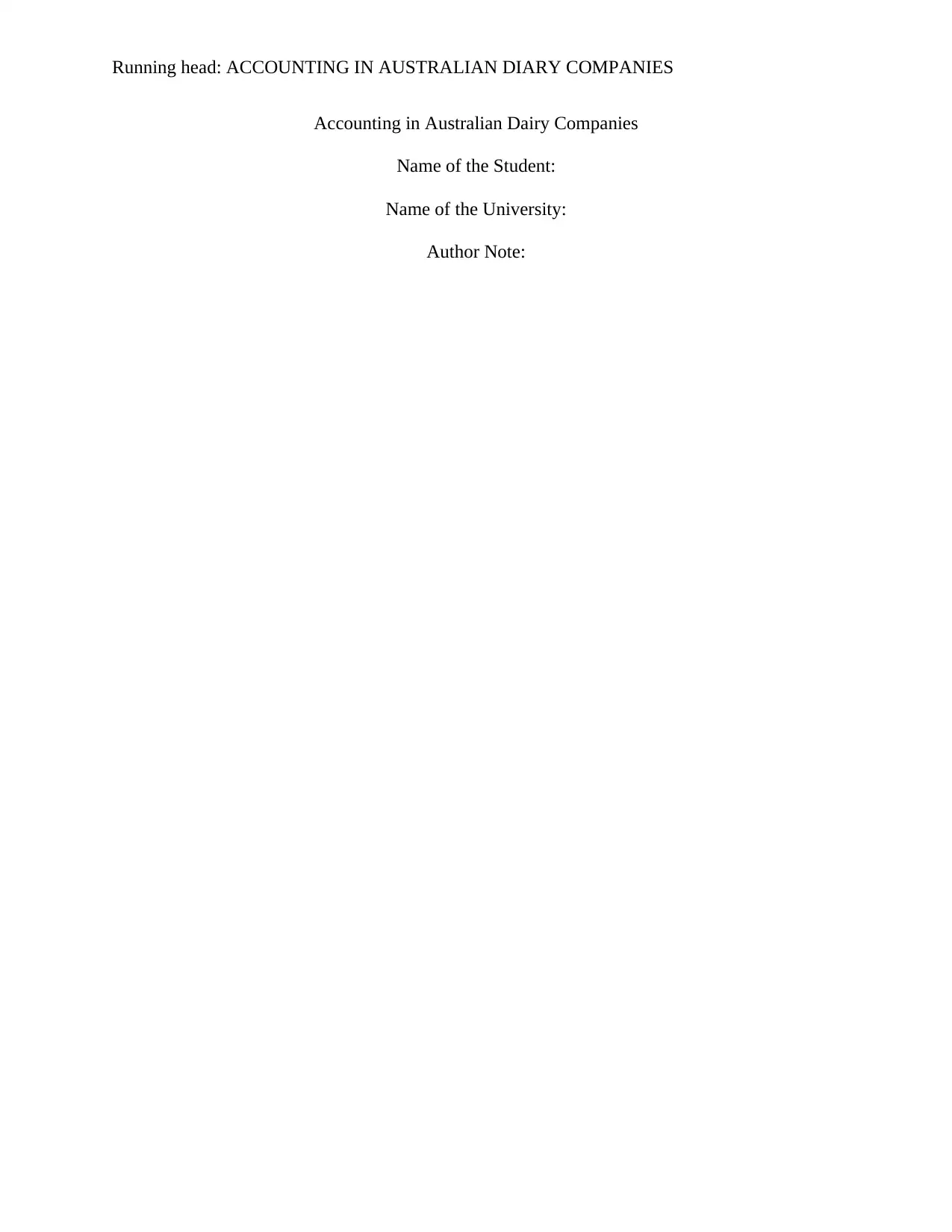
Running head: ACCOUNTING IN AUSTRALIAN DIARY COMPANIES
Accounting in Australian Dairy Companies
Name of the Student:
Name of the University:
Author Note:
Accounting in Australian Dairy Companies
Name of the Student:
Name of the University:
Author Note:
Paraphrase This Document
Need a fresh take? Get an instant paraphrase of this document with our AI Paraphraser
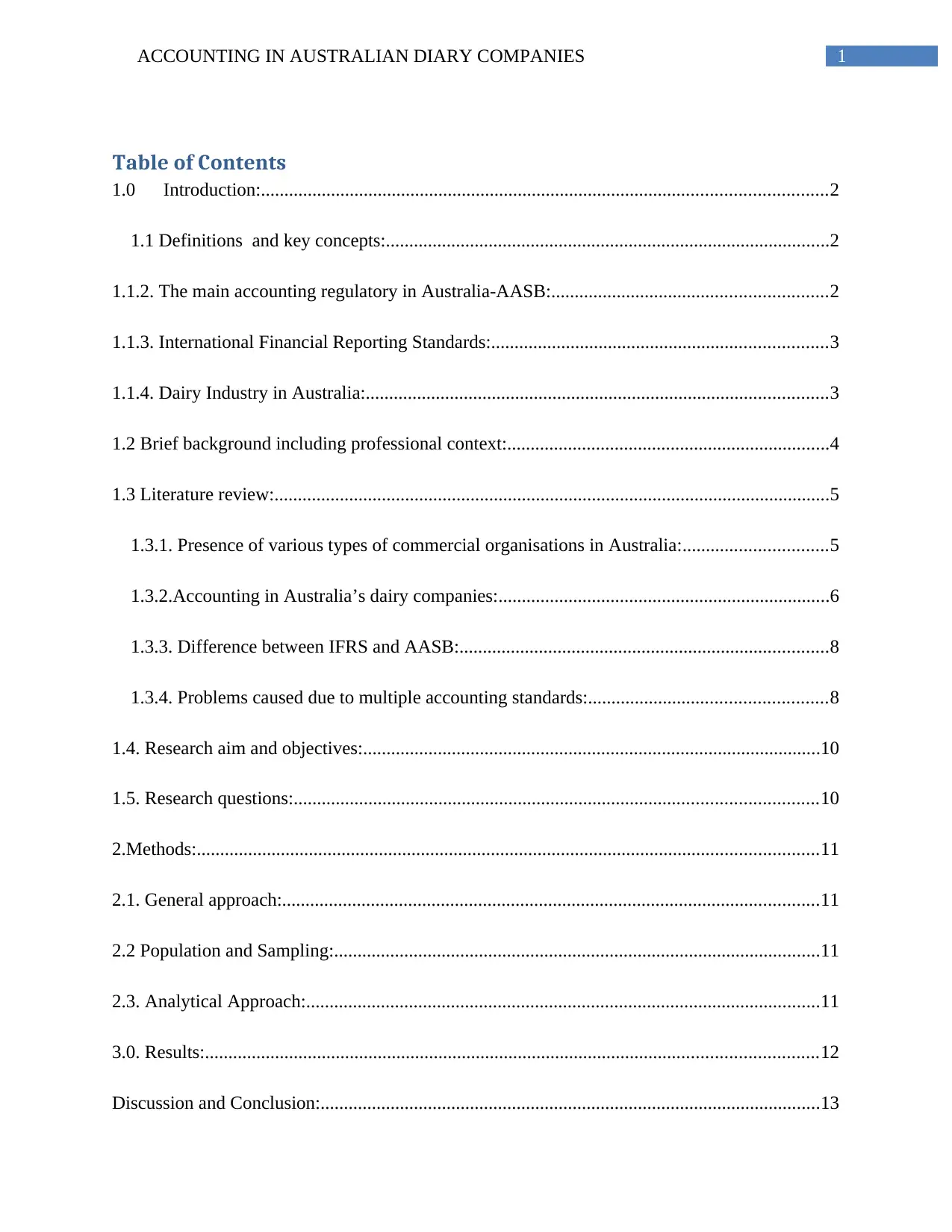
1ACCOUNTING IN AUSTRALIAN DIARY COMPANIES
Table of Contents
1.0 Introduction:.........................................................................................................................2
1.1 Definitions and key concepts:...............................................................................................2
1.1.2. The main accounting regulatory in Australia-AASB:...........................................................2
1.1.3. International Financial Reporting Standards:........................................................................3
1.1.4. Dairy Industry in Australia:...................................................................................................3
1.2 Brief background including professional context:.....................................................................4
1.3 Literature review:.......................................................................................................................5
1.3.1. Presence of various types of commercial organisations in Australia:...............................5
1.3.2.Accounting in Australia’s dairy companies:.......................................................................6
1.3.3. Difference between IFRS and AASB:...............................................................................8
1.3.4. Problems caused due to multiple accounting standards:...................................................8
1.4. Research aim and objectives:..................................................................................................10
1.5. Research questions:................................................................................................................10
2.Methods:.....................................................................................................................................11
2.1. General approach:...................................................................................................................11
2.2 Population and Sampling:........................................................................................................11
2.3. Analytical Approach:..............................................................................................................11
3.0. Results:...................................................................................................................................12
Discussion and Conclusion:...........................................................................................................13
Table of Contents
1.0 Introduction:.........................................................................................................................2
1.1 Definitions and key concepts:...............................................................................................2
1.1.2. The main accounting regulatory in Australia-AASB:...........................................................2
1.1.3. International Financial Reporting Standards:........................................................................3
1.1.4. Dairy Industry in Australia:...................................................................................................3
1.2 Brief background including professional context:.....................................................................4
1.3 Literature review:.......................................................................................................................5
1.3.1. Presence of various types of commercial organisations in Australia:...............................5
1.3.2.Accounting in Australia’s dairy companies:.......................................................................6
1.3.3. Difference between IFRS and AASB:...............................................................................8
1.3.4. Problems caused due to multiple accounting standards:...................................................8
1.4. Research aim and objectives:..................................................................................................10
1.5. Research questions:................................................................................................................10
2.Methods:.....................................................................................................................................11
2.1. General approach:...................................................................................................................11
2.2 Population and Sampling:........................................................................................................11
2.3. Analytical Approach:..............................................................................................................11
3.0. Results:...................................................................................................................................12
Discussion and Conclusion:...........................................................................................................13
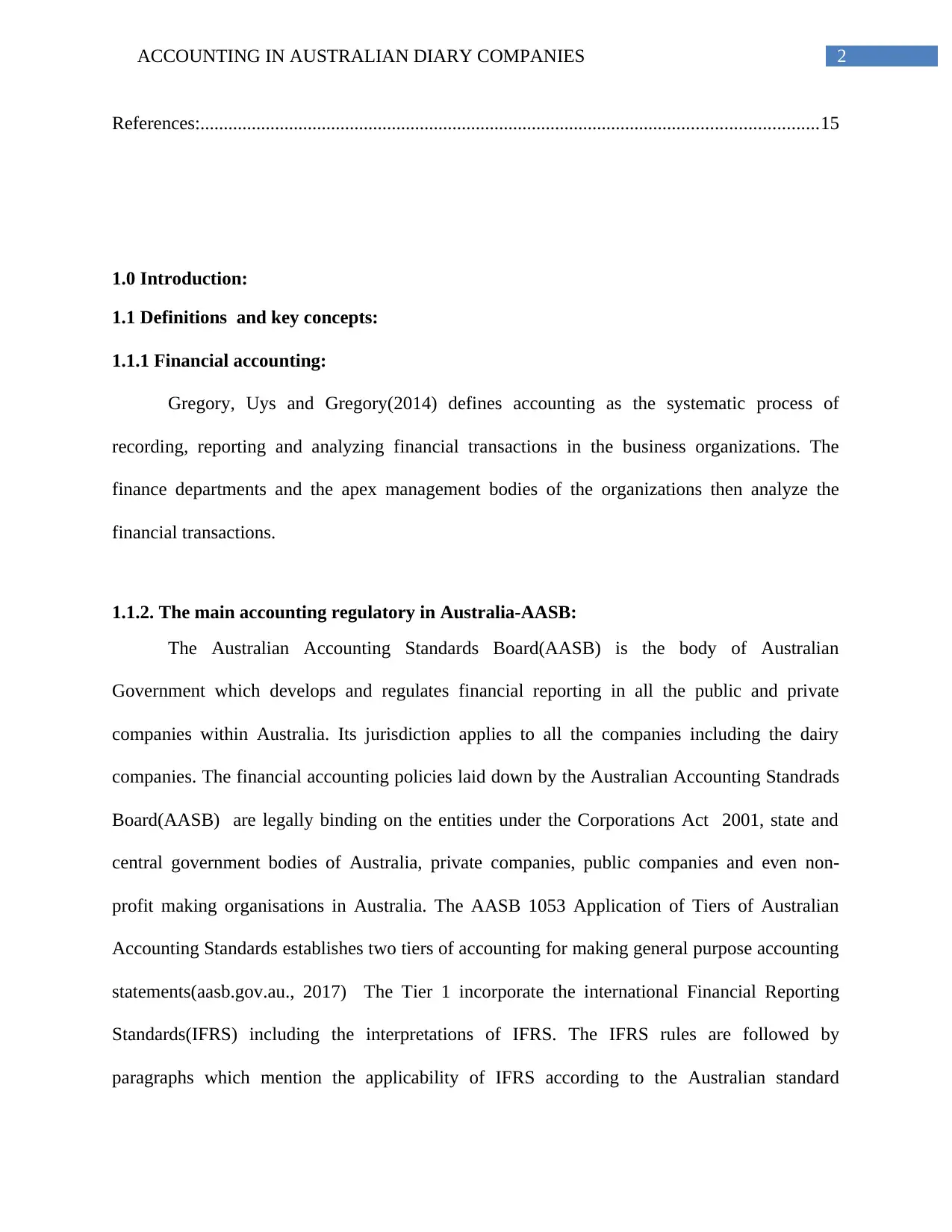
2ACCOUNTING IN AUSTRALIAN DIARY COMPANIES
References:....................................................................................................................................15
1.0 Introduction:
1.1 Definitions and key concepts:
1.1.1 Financial accounting:
Gregory, Uys and Gregory(2014) defines accounting as the systematic process of
recording, reporting and analyzing financial transactions in the business organizations. The
finance departments and the apex management bodies of the organizations then analyze the
financial transactions.
1.1.2. The main accounting regulatory in Australia-AASB:
The Australian Accounting Standards Board(AASB) is the body of Australian
Government which develops and regulates financial reporting in all the public and private
companies within Australia. Its jurisdiction applies to all the companies including the dairy
companies. The financial accounting policies laid down by the Australian Accounting Standrads
Board(AASB) are legally binding on the entities under the Corporations Act 2001, state and
central government bodies of Australia, private companies, public companies and even non-
profit making organisations in Australia. The AASB 1053 Application of Tiers of Australian
Accounting Standards establishes two tiers of accounting for making general purpose accounting
statements(aasb.gov.au., 2017) The Tier 1 incorporate the international Financial Reporting
Standards(IFRS) including the interpretations of IFRS. The IFRS rules are followed by
paragraphs which mention the applicability of IFRS according to the Australian standard
References:....................................................................................................................................15
1.0 Introduction:
1.1 Definitions and key concepts:
1.1.1 Financial accounting:
Gregory, Uys and Gregory(2014) defines accounting as the systematic process of
recording, reporting and analyzing financial transactions in the business organizations. The
finance departments and the apex management bodies of the organizations then analyze the
financial transactions.
1.1.2. The main accounting regulatory in Australia-AASB:
The Australian Accounting Standards Board(AASB) is the body of Australian
Government which develops and regulates financial reporting in all the public and private
companies within Australia. Its jurisdiction applies to all the companies including the dairy
companies. The financial accounting policies laid down by the Australian Accounting Standrads
Board(AASB) are legally binding on the entities under the Corporations Act 2001, state and
central government bodies of Australia, private companies, public companies and even non-
profit making organisations in Australia. The AASB 1053 Application of Tiers of Australian
Accounting Standards establishes two tiers of accounting for making general purpose accounting
statements(aasb.gov.au., 2017) The Tier 1 incorporate the international Financial Reporting
Standards(IFRS) including the interpretations of IFRS. The IFRS rules are followed by
paragraphs which mention the applicability of IFRS according to the Australian standard
⊘ This is a preview!⊘
Do you want full access?
Subscribe today to unlock all pages.

Trusted by 1+ million students worldwide
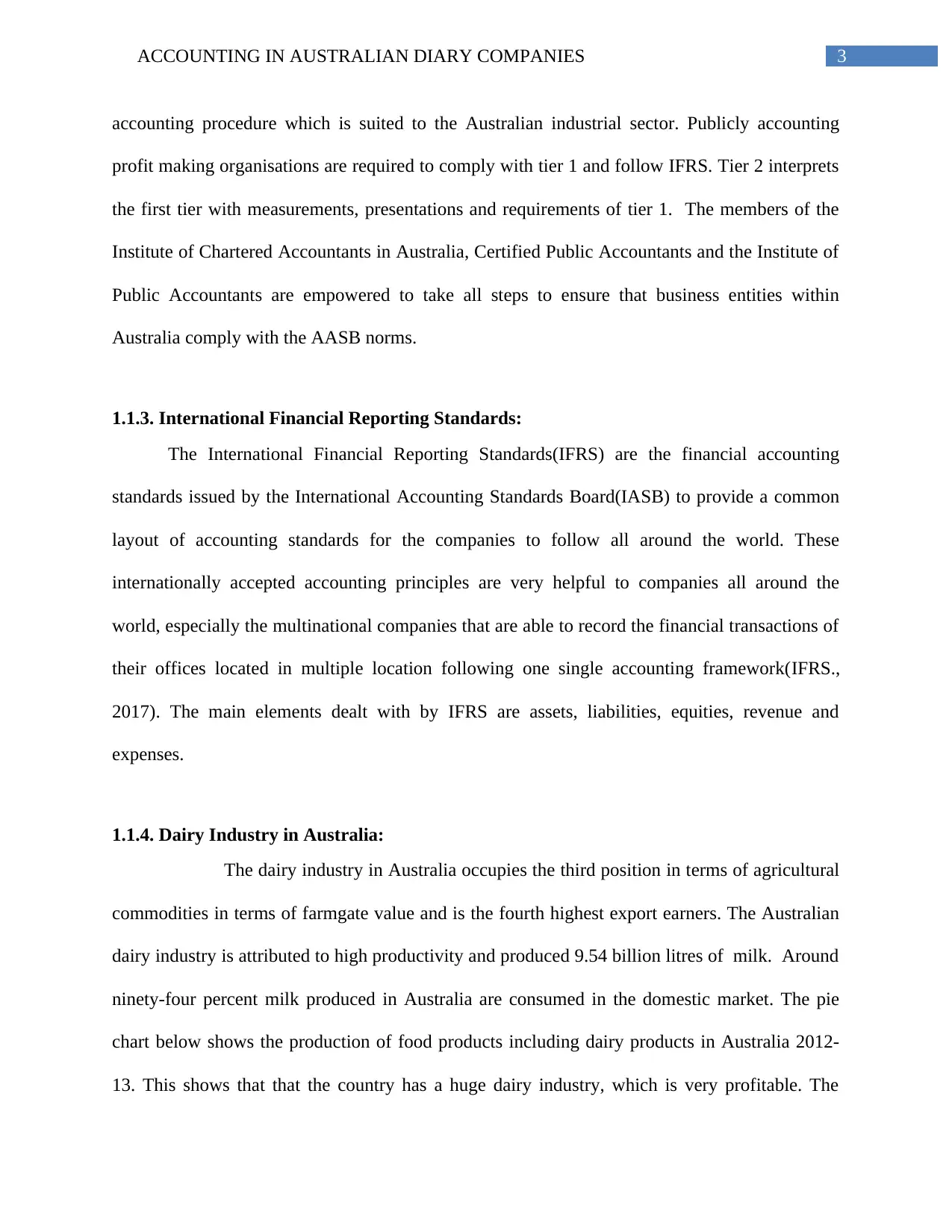
3ACCOUNTING IN AUSTRALIAN DIARY COMPANIES
accounting procedure which is suited to the Australian industrial sector. Publicly accounting
profit making organisations are required to comply with tier 1 and follow IFRS. Tier 2 interprets
the first tier with measurements, presentations and requirements of tier 1. The members of the
Institute of Chartered Accountants in Australia, Certified Public Accountants and the Institute of
Public Accountants are empowered to take all steps to ensure that business entities within
Australia comply with the AASB norms.
1.1.3. International Financial Reporting Standards:
The International Financial Reporting Standards(IFRS) are the financial accounting
standards issued by the International Accounting Standards Board(IASB) to provide a common
layout of accounting standards for the companies to follow all around the world. These
internationally accepted accounting principles are very helpful to companies all around the
world, especially the multinational companies that are able to record the financial transactions of
their offices located in multiple location following one single accounting framework(IFRS.,
2017). The main elements dealt with by IFRS are assets, liabilities, equities, revenue and
expenses.
1.1.4. Dairy Industry in Australia:
The dairy industry in Australia occupies the third position in terms of agricultural
commodities in terms of farmgate value and is the fourth highest export earners. The Australian
dairy industry is attributed to high productivity and produced 9.54 billion litres of milk. Around
ninety-four percent milk produced in Australia are consumed in the domestic market. The pie
chart below shows the production of food products including dairy products in Australia 2012-
13. This shows that that the country has a huge dairy industry, which is very profitable. The
accounting procedure which is suited to the Australian industrial sector. Publicly accounting
profit making organisations are required to comply with tier 1 and follow IFRS. Tier 2 interprets
the first tier with measurements, presentations and requirements of tier 1. The members of the
Institute of Chartered Accountants in Australia, Certified Public Accountants and the Institute of
Public Accountants are empowered to take all steps to ensure that business entities within
Australia comply with the AASB norms.
1.1.3. International Financial Reporting Standards:
The International Financial Reporting Standards(IFRS) are the financial accounting
standards issued by the International Accounting Standards Board(IASB) to provide a common
layout of accounting standards for the companies to follow all around the world. These
internationally accepted accounting principles are very helpful to companies all around the
world, especially the multinational companies that are able to record the financial transactions of
their offices located in multiple location following one single accounting framework(IFRS.,
2017). The main elements dealt with by IFRS are assets, liabilities, equities, revenue and
expenses.
1.1.4. Dairy Industry in Australia:
The dairy industry in Australia occupies the third position in terms of agricultural
commodities in terms of farmgate value and is the fourth highest export earners. The Australian
dairy industry is attributed to high productivity and produced 9.54 billion litres of milk. Around
ninety-four percent milk produced in Australia are consumed in the domestic market. The pie
chart below shows the production of food products including dairy products in Australia 2012-
13. This shows that that the country has a huge dairy industry, which is very profitable. The
Paraphrase This Document
Need a fresh take? Get an instant paraphrase of this document with our AI Paraphraser
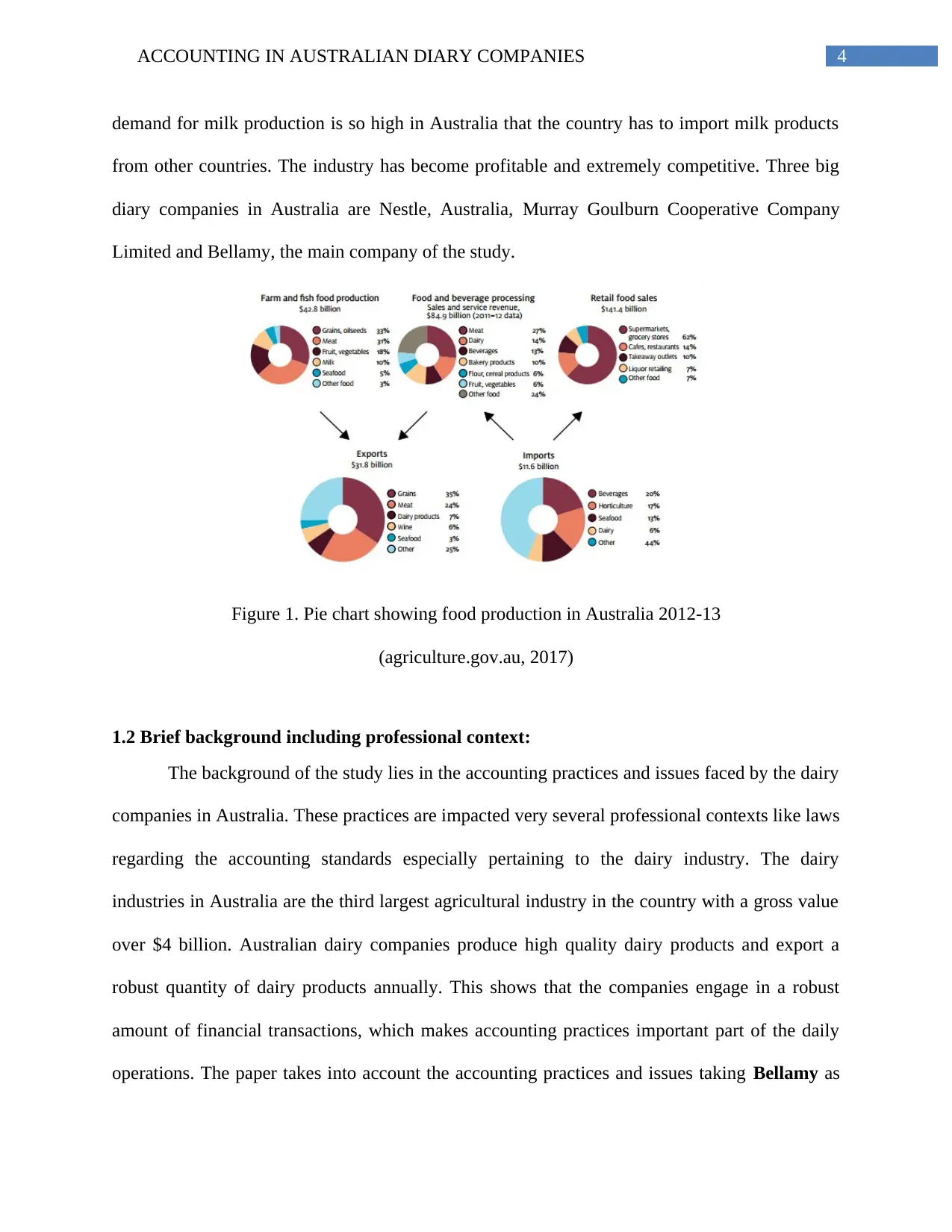
4ACCOUNTING IN AUSTRALIAN DIARY COMPANIES
demand for milk production is so high in Australia that the country has to import milk products
from other countries. The industry has become profitable and extremely competitive. Three big
diary companies in Australia are Nestle, Australia, Murray Goulburn Cooperative Company
Limited and Bellamy, the main company of the study.
Figure 1. Pie chart showing food production in Australia 2012-13
(agriculture.gov.au, 2017)
1.2 Brief background including professional context:
The background of the study lies in the accounting practices and issues faced by the dairy
companies in Australia. These practices are impacted very several professional contexts like laws
regarding the accounting standards especially pertaining to the dairy industry. The dairy
industries in Australia are the third largest agricultural industry in the country with a gross value
over $4 billion. Australian dairy companies produce high quality dairy products and export a
robust quantity of dairy products annually. This shows that the companies engage in a robust
amount of financial transactions, which makes accounting practices important part of the daily
operations. The paper takes into account the accounting practices and issues taking Bellamy as
demand for milk production is so high in Australia that the country has to import milk products
from other countries. The industry has become profitable and extremely competitive. Three big
diary companies in Australia are Nestle, Australia, Murray Goulburn Cooperative Company
Limited and Bellamy, the main company of the study.
Figure 1. Pie chart showing food production in Australia 2012-13
(agriculture.gov.au, 2017)
1.2 Brief background including professional context:
The background of the study lies in the accounting practices and issues faced by the dairy
companies in Australia. These practices are impacted very several professional contexts like laws
regarding the accounting standards especially pertaining to the dairy industry. The dairy
industries in Australia are the third largest agricultural industry in the country with a gross value
over $4 billion. Australian dairy companies produce high quality dairy products and export a
robust quantity of dairy products annually. This shows that the companies engage in a robust
amount of financial transactions, which makes accounting practices important part of the daily
operations. The paper takes into account the accounting practices and issues taking Bellamy as
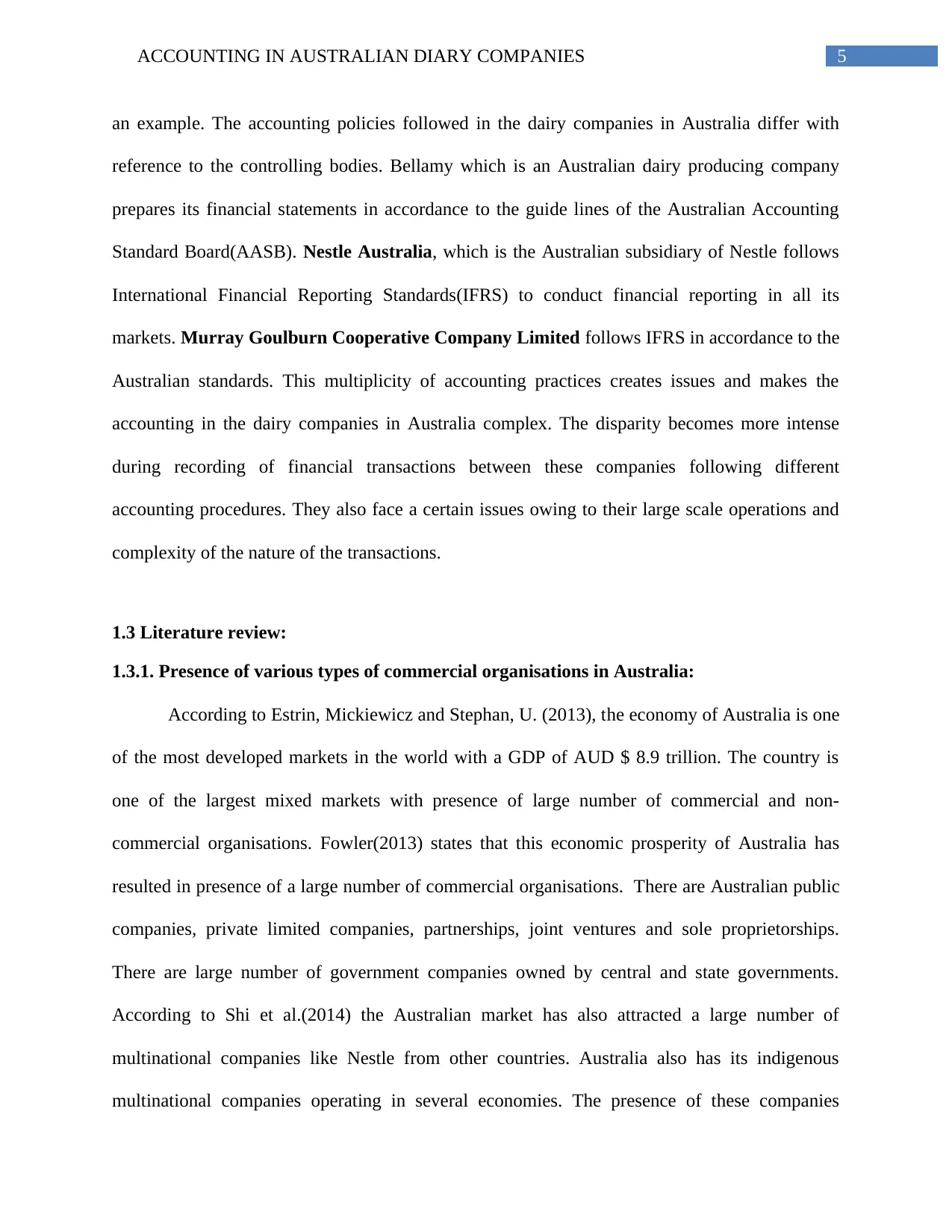
5ACCOUNTING IN AUSTRALIAN DIARY COMPANIES
an example. The accounting policies followed in the dairy companies in Australia differ with
reference to the controlling bodies. Bellamy which is an Australian dairy producing company
prepares its financial statements in accordance to the guide lines of the Australian Accounting
Standard Board(AASB). Nestle Australia, which is the Australian subsidiary of Nestle follows
International Financial Reporting Standards(IFRS) to conduct financial reporting in all its
markets. Murray Goulburn Cooperative Company Limited follows IFRS in accordance to the
Australian standards. This multiplicity of accounting practices creates issues and makes the
accounting in the dairy companies in Australia complex. The disparity becomes more intense
during recording of financial transactions between these companies following different
accounting procedures. They also face a certain issues owing to their large scale operations and
complexity of the nature of the transactions.
1.3 Literature review:
1.3.1. Presence of various types of commercial organisations in Australia:
According to Estrin, Mickiewicz and Stephan, U. (2013), the economy of Australia is one
of the most developed markets in the world with a GDP of AUD $ 8.9 trillion. The country is
one of the largest mixed markets with presence of large number of commercial and non-
commercial organisations. Fowler(2013) states that this economic prosperity of Australia has
resulted in presence of a large number of commercial organisations. There are Australian public
companies, private limited companies, partnerships, joint ventures and sole proprietorships.
There are large number of government companies owned by central and state governments.
According to Shi et al.(2014) the Australian market has also attracted a large number of
multinational companies like Nestle from other countries. Australia also has its indigenous
multinational companies operating in several economies. The presence of these companies
an example. The accounting policies followed in the dairy companies in Australia differ with
reference to the controlling bodies. Bellamy which is an Australian dairy producing company
prepares its financial statements in accordance to the guide lines of the Australian Accounting
Standard Board(AASB). Nestle Australia, which is the Australian subsidiary of Nestle follows
International Financial Reporting Standards(IFRS) to conduct financial reporting in all its
markets. Murray Goulburn Cooperative Company Limited follows IFRS in accordance to the
Australian standards. This multiplicity of accounting practices creates issues and makes the
accounting in the dairy companies in Australia complex. The disparity becomes more intense
during recording of financial transactions between these companies following different
accounting procedures. They also face a certain issues owing to their large scale operations and
complexity of the nature of the transactions.
1.3 Literature review:
1.3.1. Presence of various types of commercial organisations in Australia:
According to Estrin, Mickiewicz and Stephan, U. (2013), the economy of Australia is one
of the most developed markets in the world with a GDP of AUD $ 8.9 trillion. The country is
one of the largest mixed markets with presence of large number of commercial and non-
commercial organisations. Fowler(2013) states that this economic prosperity of Australia has
resulted in presence of a large number of commercial organisations. There are Australian public
companies, private limited companies, partnerships, joint ventures and sole proprietorships.
There are large number of government companies owned by central and state governments.
According to Shi et al.(2014) the Australian market has also attracted a large number of
multinational companies like Nestle from other countries. Australia also has its indigenous
multinational companies operating in several economies. The presence of these companies
⊘ This is a preview!⊘
Do you want full access?
Subscribe today to unlock all pages.

Trusted by 1+ million students worldwide
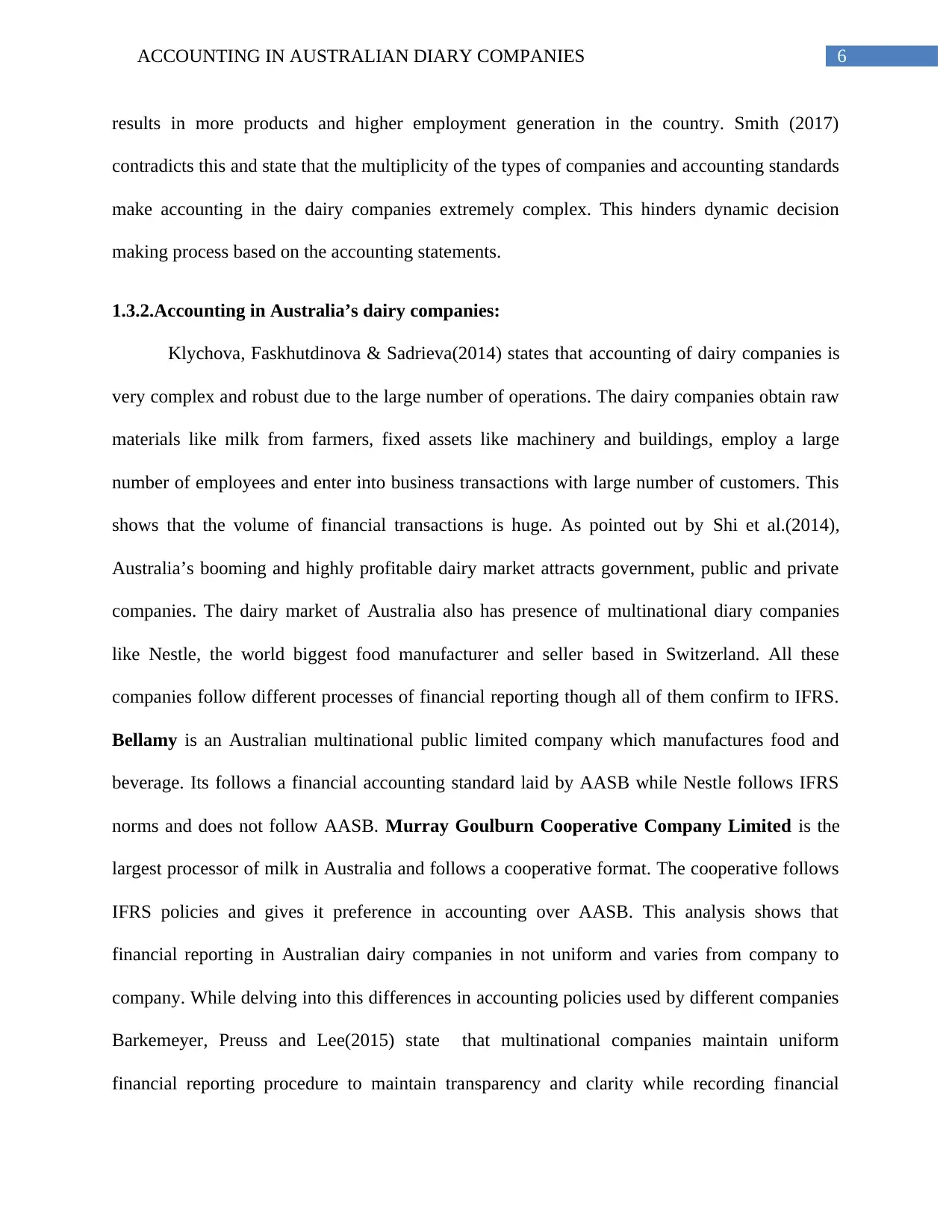
6ACCOUNTING IN AUSTRALIAN DIARY COMPANIES
results in more products and higher employment generation in the country. Smith (2017)
contradicts this and state that the multiplicity of the types of companies and accounting standards
make accounting in the dairy companies extremely complex. This hinders dynamic decision
making process based on the accounting statements.
1.3.2.Accounting in Australia’s dairy companies:
Klychova, Faskhutdinova & Sadrieva(2014) states that accounting of dairy companies is
very complex and robust due to the large number of operations. The dairy companies obtain raw
materials like milk from farmers, fixed assets like machinery and buildings, employ a large
number of employees and enter into business transactions with large number of customers. This
shows that the volume of financial transactions is huge. As pointed out by Shi et al.(2014),
Australia’s booming and highly profitable dairy market attracts government, public and private
companies. The dairy market of Australia also has presence of multinational diary companies
like Nestle, the world biggest food manufacturer and seller based in Switzerland. All these
companies follow different processes of financial reporting though all of them confirm to IFRS.
Bellamy is an Australian multinational public limited company which manufactures food and
beverage. Its follows a financial accounting standard laid by AASB while Nestle follows IFRS
norms and does not follow AASB. Murray Goulburn Cooperative Company Limited is the
largest processor of milk in Australia and follows a cooperative format. The cooperative follows
IFRS policies and gives it preference in accounting over AASB. This analysis shows that
financial reporting in Australian dairy companies in not uniform and varies from company to
company. While delving into this differences in accounting policies used by different companies
Barkemeyer, Preuss and Lee(2015) state that multinational companies maintain uniform
financial reporting procedure to maintain transparency and clarity while recording financial
results in more products and higher employment generation in the country. Smith (2017)
contradicts this and state that the multiplicity of the types of companies and accounting standards
make accounting in the dairy companies extremely complex. This hinders dynamic decision
making process based on the accounting statements.
1.3.2.Accounting in Australia’s dairy companies:
Klychova, Faskhutdinova & Sadrieva(2014) states that accounting of dairy companies is
very complex and robust due to the large number of operations. The dairy companies obtain raw
materials like milk from farmers, fixed assets like machinery and buildings, employ a large
number of employees and enter into business transactions with large number of customers. This
shows that the volume of financial transactions is huge. As pointed out by Shi et al.(2014),
Australia’s booming and highly profitable dairy market attracts government, public and private
companies. The dairy market of Australia also has presence of multinational diary companies
like Nestle, the world biggest food manufacturer and seller based in Switzerland. All these
companies follow different processes of financial reporting though all of them confirm to IFRS.
Bellamy is an Australian multinational public limited company which manufactures food and
beverage. Its follows a financial accounting standard laid by AASB while Nestle follows IFRS
norms and does not follow AASB. Murray Goulburn Cooperative Company Limited is the
largest processor of milk in Australia and follows a cooperative format. The cooperative follows
IFRS policies and gives it preference in accounting over AASB. This analysis shows that
financial reporting in Australian dairy companies in not uniform and varies from company to
company. While delving into this differences in accounting policies used by different companies
Barkemeyer, Preuss and Lee(2015) state that multinational companies maintain uniform
financial reporting procedure to maintain transparency and clarity while recording financial
Paraphrase This Document
Need a fresh take? Get an instant paraphrase of this document with our AI Paraphraser
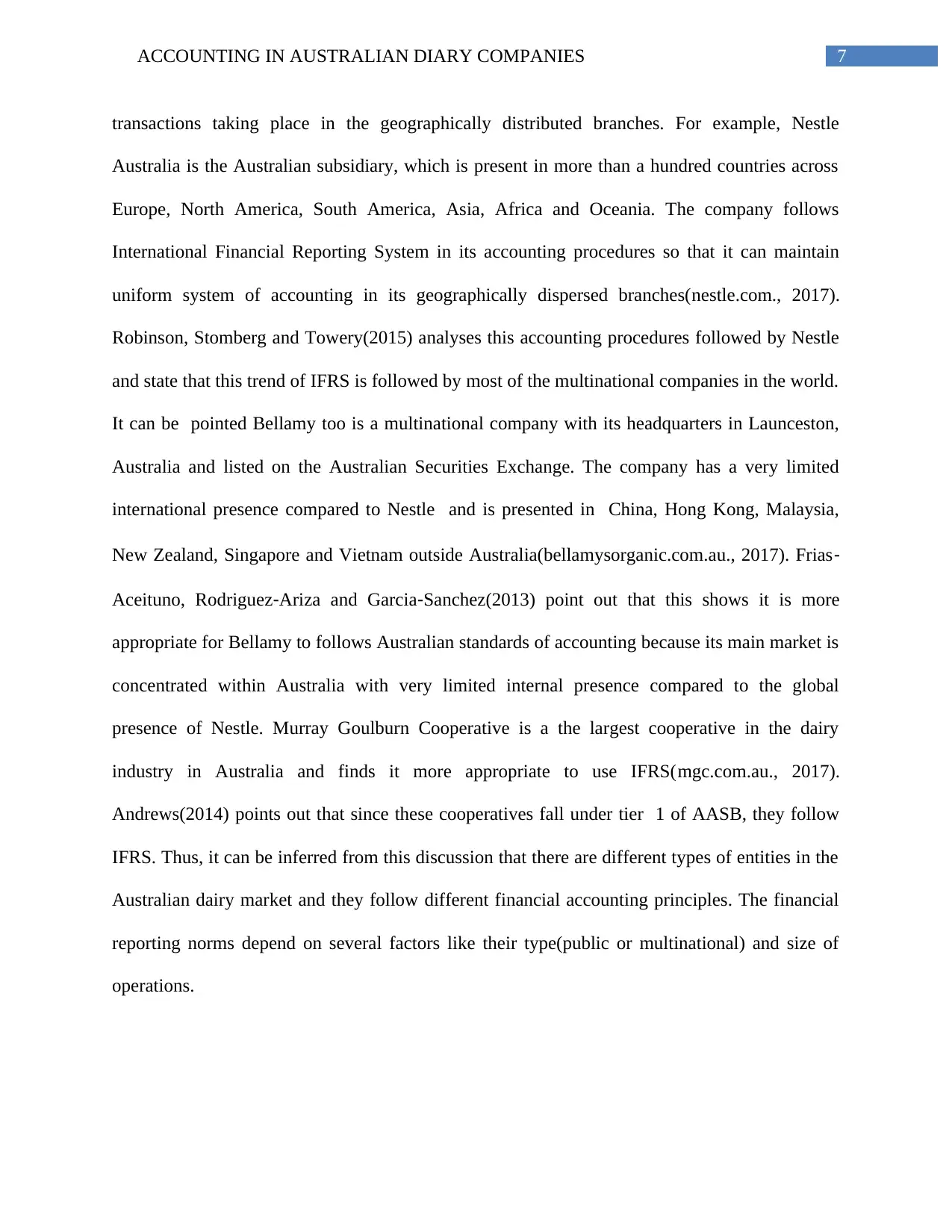
7ACCOUNTING IN AUSTRALIAN DIARY COMPANIES
transactions taking place in the geographically distributed branches. For example, Nestle
Australia is the Australian subsidiary, which is present in more than a hundred countries across
Europe, North America, South America, Asia, Africa and Oceania. The company follows
International Financial Reporting System in its accounting procedures so that it can maintain
uniform system of accounting in its geographically dispersed branches(nestle.com., 2017).
Robinson, Stomberg and Towery(2015) analyses this accounting procedures followed by Nestle
and state that this trend of IFRS is followed by most of the multinational companies in the world.
It can be pointed Bellamy too is a multinational company with its headquarters in Launceston,
Australia and listed on the Australian Securities Exchange. The company has a very limited
international presence compared to Nestle and is presented in China, Hong Kong, Malaysia,
New Zealand, Singapore and Vietnam outside Australia(bellamysorganic.com.au., 2017). Frias‐
Aceituno, Rodriguez‐Ariza and Garcia‐Sanchez(2013) point out that this shows it is more
appropriate for Bellamy to follows Australian standards of accounting because its main market is
concentrated within Australia with very limited internal presence compared to the global
presence of Nestle. Murray Goulburn Cooperative is a the largest cooperative in the dairy
industry in Australia and finds it more appropriate to use IFRS(mgc.com.au., 2017).
Andrews(2014) points out that since these cooperatives fall under tier 1 of AASB, they follow
IFRS. Thus, it can be inferred from this discussion that there are different types of entities in the
Australian dairy market and they follow different financial accounting principles. The financial
reporting norms depend on several factors like their type(public or multinational) and size of
operations.
transactions taking place in the geographically distributed branches. For example, Nestle
Australia is the Australian subsidiary, which is present in more than a hundred countries across
Europe, North America, South America, Asia, Africa and Oceania. The company follows
International Financial Reporting System in its accounting procedures so that it can maintain
uniform system of accounting in its geographically dispersed branches(nestle.com., 2017).
Robinson, Stomberg and Towery(2015) analyses this accounting procedures followed by Nestle
and state that this trend of IFRS is followed by most of the multinational companies in the world.
It can be pointed Bellamy too is a multinational company with its headquarters in Launceston,
Australia and listed on the Australian Securities Exchange. The company has a very limited
international presence compared to Nestle and is presented in China, Hong Kong, Malaysia,
New Zealand, Singapore and Vietnam outside Australia(bellamysorganic.com.au., 2017). Frias‐
Aceituno, Rodriguez‐Ariza and Garcia‐Sanchez(2013) point out that this shows it is more
appropriate for Bellamy to follows Australian standards of accounting because its main market is
concentrated within Australia with very limited internal presence compared to the global
presence of Nestle. Murray Goulburn Cooperative is a the largest cooperative in the dairy
industry in Australia and finds it more appropriate to use IFRS(mgc.com.au., 2017).
Andrews(2014) points out that since these cooperatives fall under tier 1 of AASB, they follow
IFRS. Thus, it can be inferred from this discussion that there are different types of entities in the
Australian dairy market and they follow different financial accounting principles. The financial
reporting norms depend on several factors like their type(public or multinational) and size of
operations.
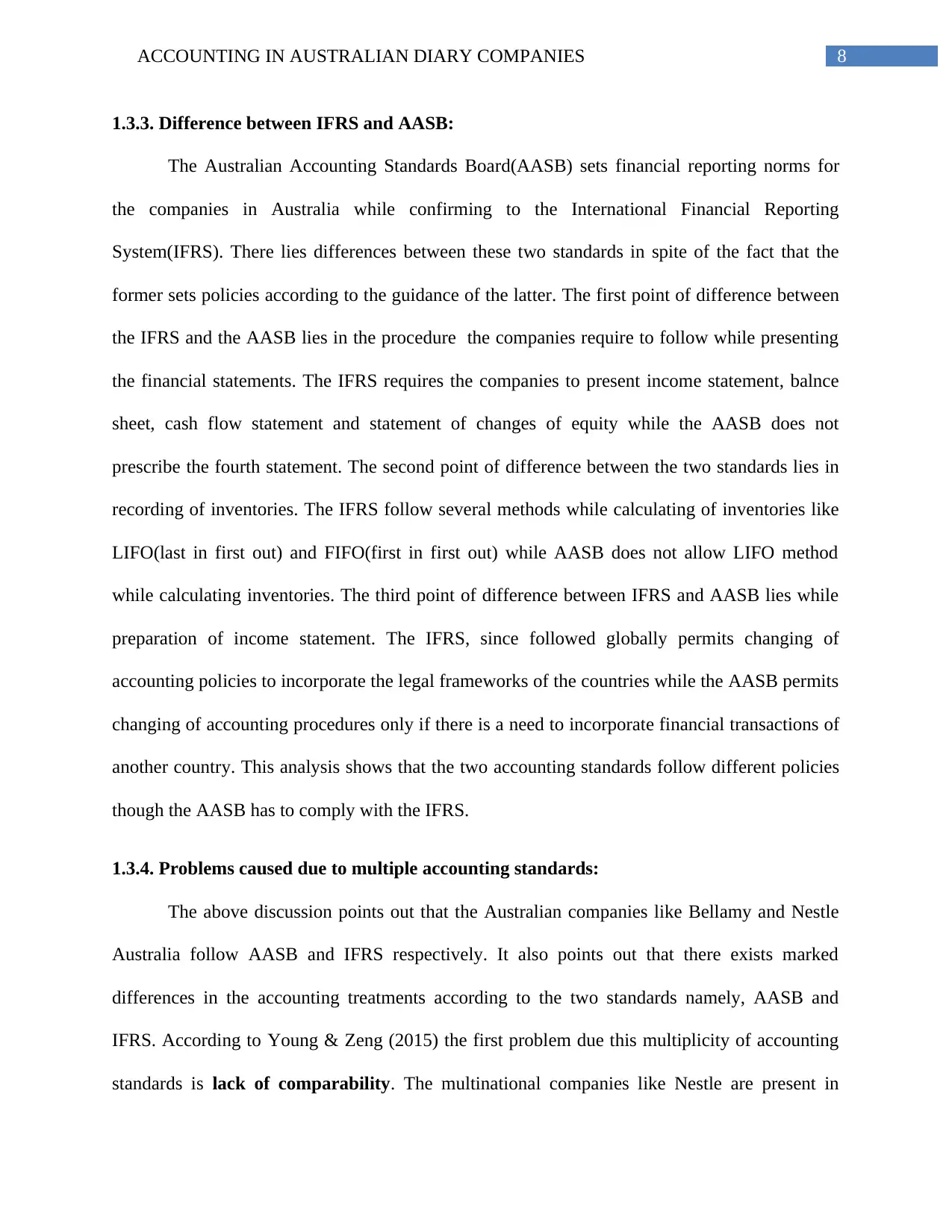
8ACCOUNTING IN AUSTRALIAN DIARY COMPANIES
1.3.3. Difference between IFRS and AASB:
The Australian Accounting Standards Board(AASB) sets financial reporting norms for
the companies in Australia while confirming to the International Financial Reporting
System(IFRS). There lies differences between these two standards in spite of the fact that the
former sets policies according to the guidance of the latter. The first point of difference between
the IFRS and the AASB lies in the procedure the companies require to follow while presenting
the financial statements. The IFRS requires the companies to present income statement, balnce
sheet, cash flow statement and statement of changes of equity while the AASB does not
prescribe the fourth statement. The second point of difference between the two standards lies in
recording of inventories. The IFRS follow several methods while calculating of inventories like
LIFO(last in first out) and FIFO(first in first out) while AASB does not allow LIFO method
while calculating inventories. The third point of difference between IFRS and AASB lies while
preparation of income statement. The IFRS, since followed globally permits changing of
accounting policies to incorporate the legal frameworks of the countries while the AASB permits
changing of accounting procedures only if there is a need to incorporate financial transactions of
another country. This analysis shows that the two accounting standards follow different policies
though the AASB has to comply with the IFRS.
1.3.4. Problems caused due to multiple accounting standards:
The above discussion points out that the Australian companies like Bellamy and Nestle
Australia follow AASB and IFRS respectively. It also points out that there exists marked
differences in the accounting treatments according to the two standards namely, AASB and
IFRS. According to Young & Zeng (2015) the first problem due this multiplicity of accounting
standards is lack of comparability. The multinational companies like Nestle are present in
1.3.3. Difference between IFRS and AASB:
The Australian Accounting Standards Board(AASB) sets financial reporting norms for
the companies in Australia while confirming to the International Financial Reporting
System(IFRS). There lies differences between these two standards in spite of the fact that the
former sets policies according to the guidance of the latter. The first point of difference between
the IFRS and the AASB lies in the procedure the companies require to follow while presenting
the financial statements. The IFRS requires the companies to present income statement, balnce
sheet, cash flow statement and statement of changes of equity while the AASB does not
prescribe the fourth statement. The second point of difference between the two standards lies in
recording of inventories. The IFRS follow several methods while calculating of inventories like
LIFO(last in first out) and FIFO(first in first out) while AASB does not allow LIFO method
while calculating inventories. The third point of difference between IFRS and AASB lies while
preparation of income statement. The IFRS, since followed globally permits changing of
accounting policies to incorporate the legal frameworks of the countries while the AASB permits
changing of accounting procedures only if there is a need to incorporate financial transactions of
another country. This analysis shows that the two accounting standards follow different policies
though the AASB has to comply with the IFRS.
1.3.4. Problems caused due to multiple accounting standards:
The above discussion points out that the Australian companies like Bellamy and Nestle
Australia follow AASB and IFRS respectively. It also points out that there exists marked
differences in the accounting treatments according to the two standards namely, AASB and
IFRS. According to Young & Zeng (2015) the first problem due this multiplicity of accounting
standards is lack of comparability. The multinational companies like Nestle are present in
⊘ This is a preview!⊘
Do you want full access?
Subscribe today to unlock all pages.

Trusted by 1+ million students worldwide
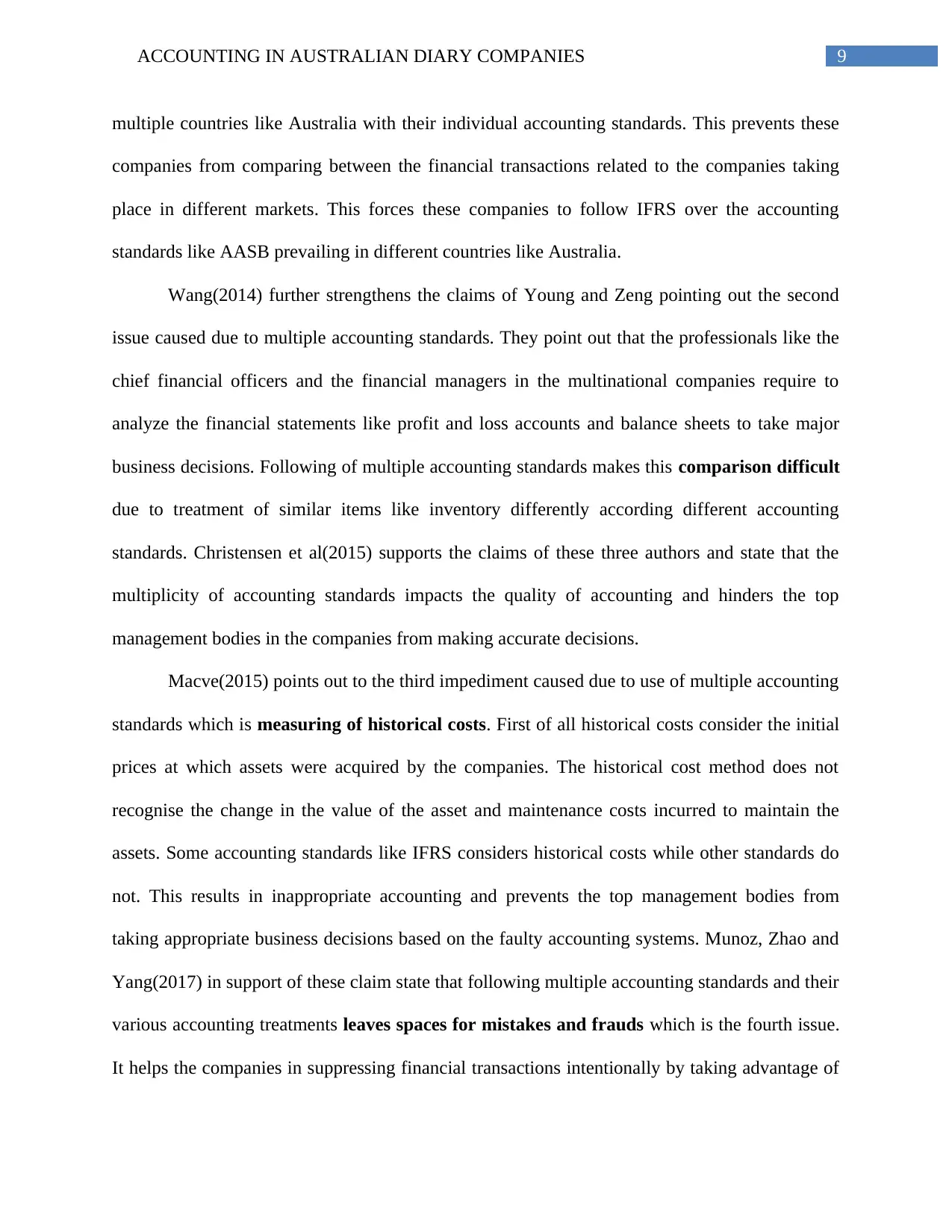
9ACCOUNTING IN AUSTRALIAN DIARY COMPANIES
multiple countries like Australia with their individual accounting standards. This prevents these
companies from comparing between the financial transactions related to the companies taking
place in different markets. This forces these companies to follow IFRS over the accounting
standards like AASB prevailing in different countries like Australia.
Wang(2014) further strengthens the claims of Young and Zeng pointing out the second
issue caused due to multiple accounting standards. They point out that the professionals like the
chief financial officers and the financial managers in the multinational companies require to
analyze the financial statements like profit and loss accounts and balance sheets to take major
business decisions. Following of multiple accounting standards makes this comparison difficult
due to treatment of similar items like inventory differently according different accounting
standards. Christensen et al(2015) supports the claims of these three authors and state that the
multiplicity of accounting standards impacts the quality of accounting and hinders the top
management bodies in the companies from making accurate decisions.
Macve(2015) points out to the third impediment caused due to use of multiple accounting
standards which is measuring of historical costs. First of all historical costs consider the initial
prices at which assets were acquired by the companies. The historical cost method does not
recognise the change in the value of the asset and maintenance costs incurred to maintain the
assets. Some accounting standards like IFRS considers historical costs while other standards do
not. This results in inappropriate accounting and prevents the top management bodies from
taking appropriate business decisions based on the faulty accounting systems. Munoz, Zhao and
Yang(2017) in support of these claim state that following multiple accounting standards and their
various accounting treatments leaves spaces for mistakes and frauds which is the fourth issue.
It helps the companies in suppressing financial transactions intentionally by taking advantage of
multiple countries like Australia with their individual accounting standards. This prevents these
companies from comparing between the financial transactions related to the companies taking
place in different markets. This forces these companies to follow IFRS over the accounting
standards like AASB prevailing in different countries like Australia.
Wang(2014) further strengthens the claims of Young and Zeng pointing out the second
issue caused due to multiple accounting standards. They point out that the professionals like the
chief financial officers and the financial managers in the multinational companies require to
analyze the financial statements like profit and loss accounts and balance sheets to take major
business decisions. Following of multiple accounting standards makes this comparison difficult
due to treatment of similar items like inventory differently according different accounting
standards. Christensen et al(2015) supports the claims of these three authors and state that the
multiplicity of accounting standards impacts the quality of accounting and hinders the top
management bodies in the companies from making accurate decisions.
Macve(2015) points out to the third impediment caused due to use of multiple accounting
standards which is measuring of historical costs. First of all historical costs consider the initial
prices at which assets were acquired by the companies. The historical cost method does not
recognise the change in the value of the asset and maintenance costs incurred to maintain the
assets. Some accounting standards like IFRS considers historical costs while other standards do
not. This results in inappropriate accounting and prevents the top management bodies from
taking appropriate business decisions based on the faulty accounting systems. Munoz, Zhao and
Yang(2017) in support of these claim state that following multiple accounting standards and their
various accounting treatments leaves spaces for mistakes and frauds which is the fourth issue.
It helps the companies in suppressing financial transactions intentionally by taking advantage of
Paraphrase This Document
Need a fresh take? Get an instant paraphrase of this document with our AI Paraphraser
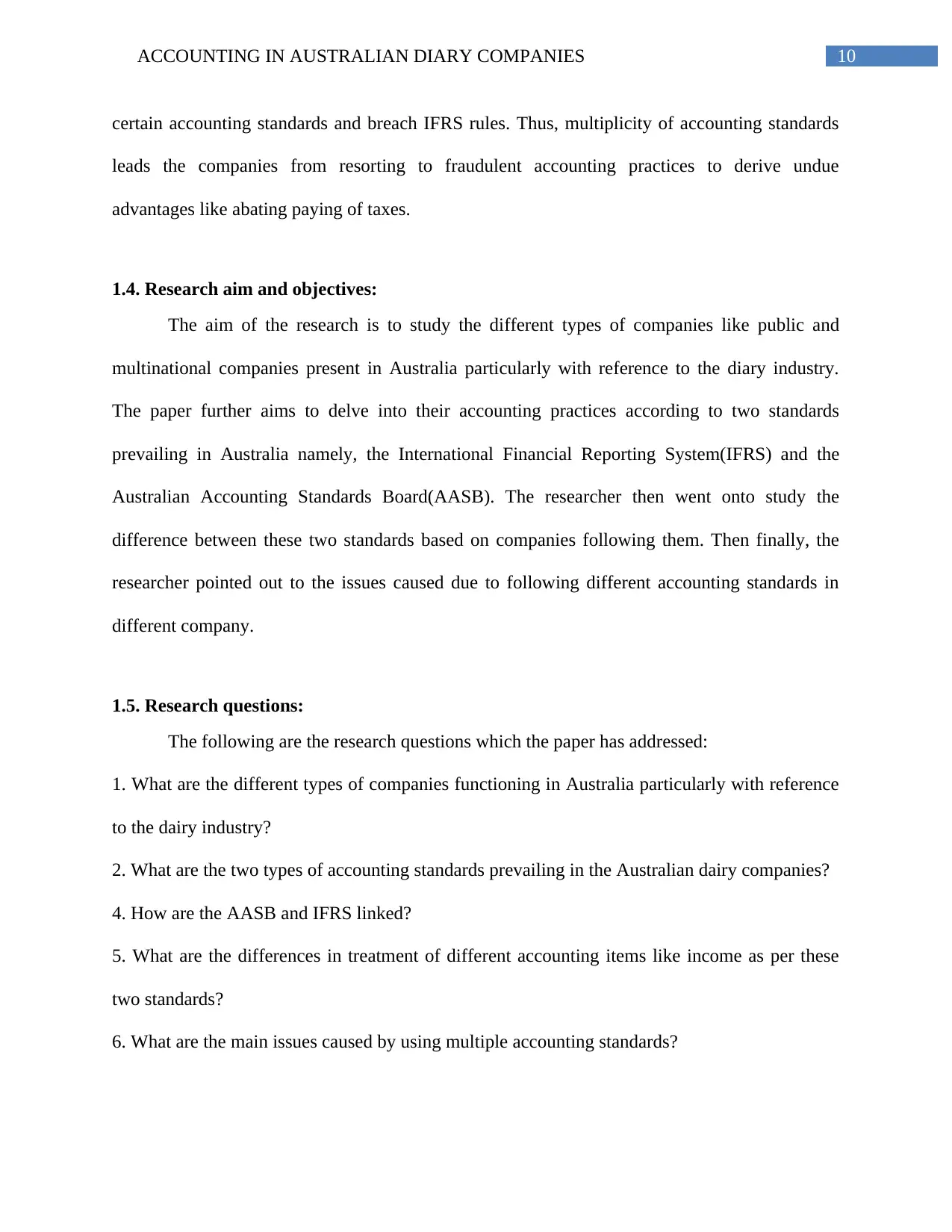
10ACCOUNTING IN AUSTRALIAN DIARY COMPANIES
certain accounting standards and breach IFRS rules. Thus, multiplicity of accounting standards
leads the companies from resorting to fraudulent accounting practices to derive undue
advantages like abating paying of taxes.
1.4. Research aim and objectives:
The aim of the research is to study the different types of companies like public and
multinational companies present in Australia particularly with reference to the diary industry.
The paper further aims to delve into their accounting practices according to two standards
prevailing in Australia namely, the International Financial Reporting System(IFRS) and the
Australian Accounting Standards Board(AASB). The researcher then went onto study the
difference between these two standards based on companies following them. Then finally, the
researcher pointed out to the issues caused due to following different accounting standards in
different company.
1.5. Research questions:
The following are the research questions which the paper has addressed:
1. What are the different types of companies functioning in Australia particularly with reference
to the dairy industry?
2. What are the two types of accounting standards prevailing in the Australian dairy companies?
4. How are the AASB and IFRS linked?
5. What are the differences in treatment of different accounting items like income as per these
two standards?
6. What are the main issues caused by using multiple accounting standards?
certain accounting standards and breach IFRS rules. Thus, multiplicity of accounting standards
leads the companies from resorting to fraudulent accounting practices to derive undue
advantages like abating paying of taxes.
1.4. Research aim and objectives:
The aim of the research is to study the different types of companies like public and
multinational companies present in Australia particularly with reference to the diary industry.
The paper further aims to delve into their accounting practices according to two standards
prevailing in Australia namely, the International Financial Reporting System(IFRS) and the
Australian Accounting Standards Board(AASB). The researcher then went onto study the
difference between these two standards based on companies following them. Then finally, the
researcher pointed out to the issues caused due to following different accounting standards in
different company.
1.5. Research questions:
The following are the research questions which the paper has addressed:
1. What are the different types of companies functioning in Australia particularly with reference
to the dairy industry?
2. What are the two types of accounting standards prevailing in the Australian dairy companies?
4. How are the AASB and IFRS linked?
5. What are the differences in treatment of different accounting items like income as per these
two standards?
6. What are the main issues caused by using multiple accounting standards?
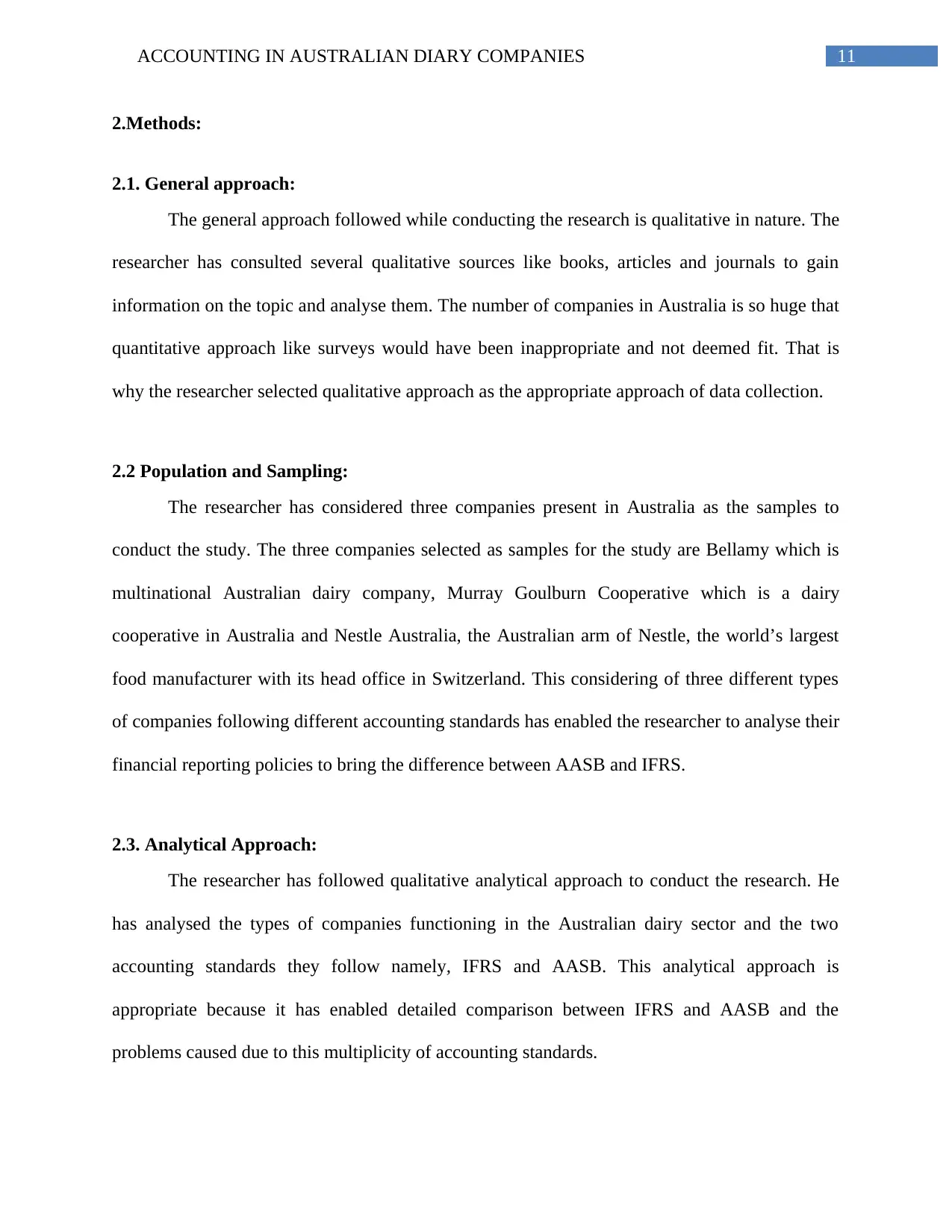
11ACCOUNTING IN AUSTRALIAN DIARY COMPANIES
2.Methods:
2.1. General approach:
The general approach followed while conducting the research is qualitative in nature. The
researcher has consulted several qualitative sources like books, articles and journals to gain
information on the topic and analyse them. The number of companies in Australia is so huge that
quantitative approach like surveys would have been inappropriate and not deemed fit. That is
why the researcher selected qualitative approach as the appropriate approach of data collection.
2.2 Population and Sampling:
The researcher has considered three companies present in Australia as the samples to
conduct the study. The three companies selected as samples for the study are Bellamy which is
multinational Australian dairy company, Murray Goulburn Cooperative which is a dairy
cooperative in Australia and Nestle Australia, the Australian arm of Nestle, the world’s largest
food manufacturer with its head office in Switzerland. This considering of three different types
of companies following different accounting standards has enabled the researcher to analyse their
financial reporting policies to bring the difference between AASB and IFRS.
2.3. Analytical Approach:
The researcher has followed qualitative analytical approach to conduct the research. He
has analysed the types of companies functioning in the Australian dairy sector and the two
accounting standards they follow namely, IFRS and AASB. This analytical approach is
appropriate because it has enabled detailed comparison between IFRS and AASB and the
problems caused due to this multiplicity of accounting standards.
2.Methods:
2.1. General approach:
The general approach followed while conducting the research is qualitative in nature. The
researcher has consulted several qualitative sources like books, articles and journals to gain
information on the topic and analyse them. The number of companies in Australia is so huge that
quantitative approach like surveys would have been inappropriate and not deemed fit. That is
why the researcher selected qualitative approach as the appropriate approach of data collection.
2.2 Population and Sampling:
The researcher has considered three companies present in Australia as the samples to
conduct the study. The three companies selected as samples for the study are Bellamy which is
multinational Australian dairy company, Murray Goulburn Cooperative which is a dairy
cooperative in Australia and Nestle Australia, the Australian arm of Nestle, the world’s largest
food manufacturer with its head office in Switzerland. This considering of three different types
of companies following different accounting standards has enabled the researcher to analyse their
financial reporting policies to bring the difference between AASB and IFRS.
2.3. Analytical Approach:
The researcher has followed qualitative analytical approach to conduct the research. He
has analysed the types of companies functioning in the Australian dairy sector and the two
accounting standards they follow namely, IFRS and AASB. This analytical approach is
appropriate because it has enabled detailed comparison between IFRS and AASB and the
problems caused due to this multiplicity of accounting standards.
⊘ This is a preview!⊘
Do you want full access?
Subscribe today to unlock all pages.

Trusted by 1+ million students worldwide
1 out of 18
Related Documents
Your All-in-One AI-Powered Toolkit for Academic Success.
+13062052269
info@desklib.com
Available 24*7 on WhatsApp / Email
![[object Object]](/_next/static/media/star-bottom.7253800d.svg)
Unlock your academic potential
Copyright © 2020–2025 A2Z Services. All Rights Reserved. Developed and managed by ZUCOL.





